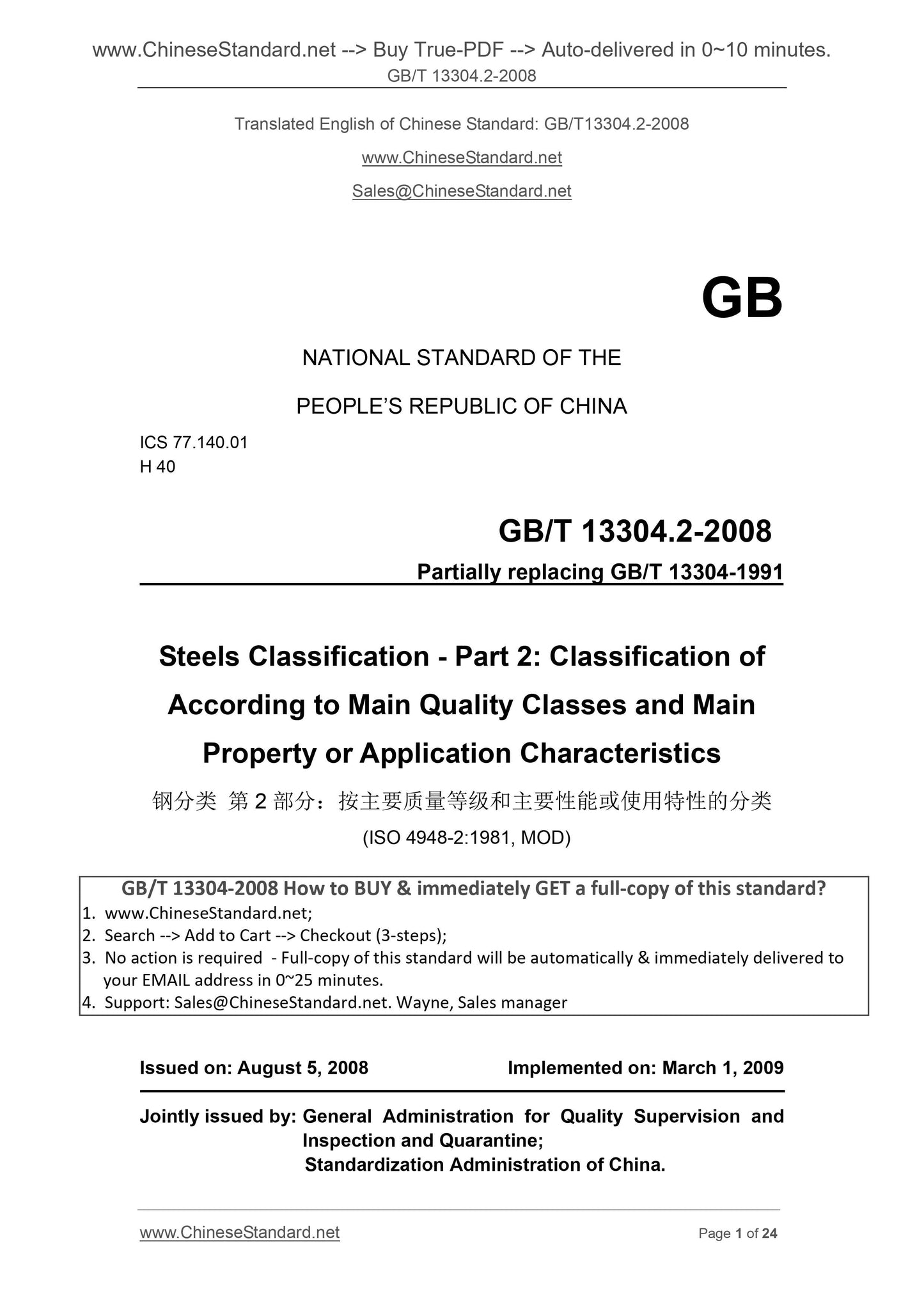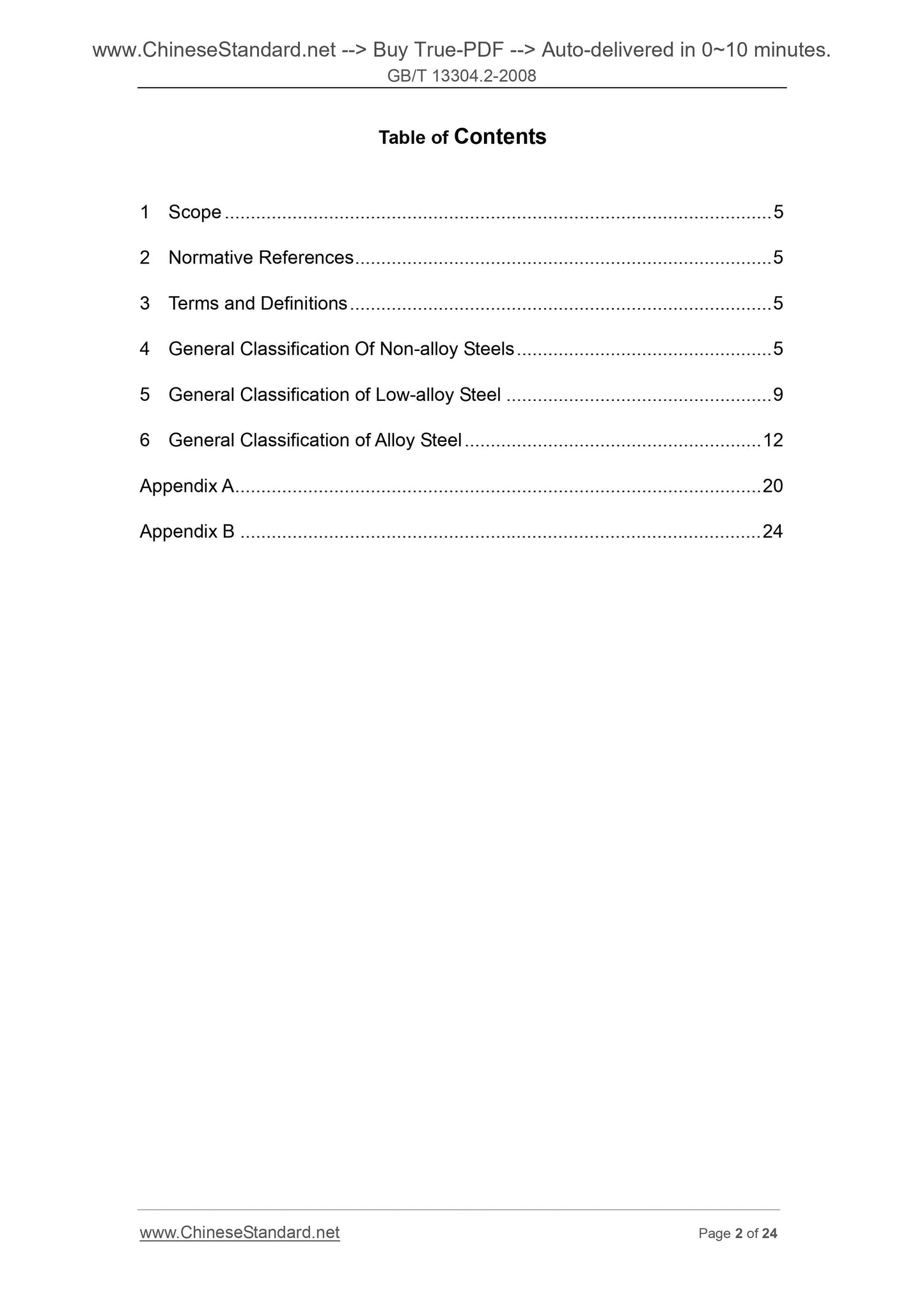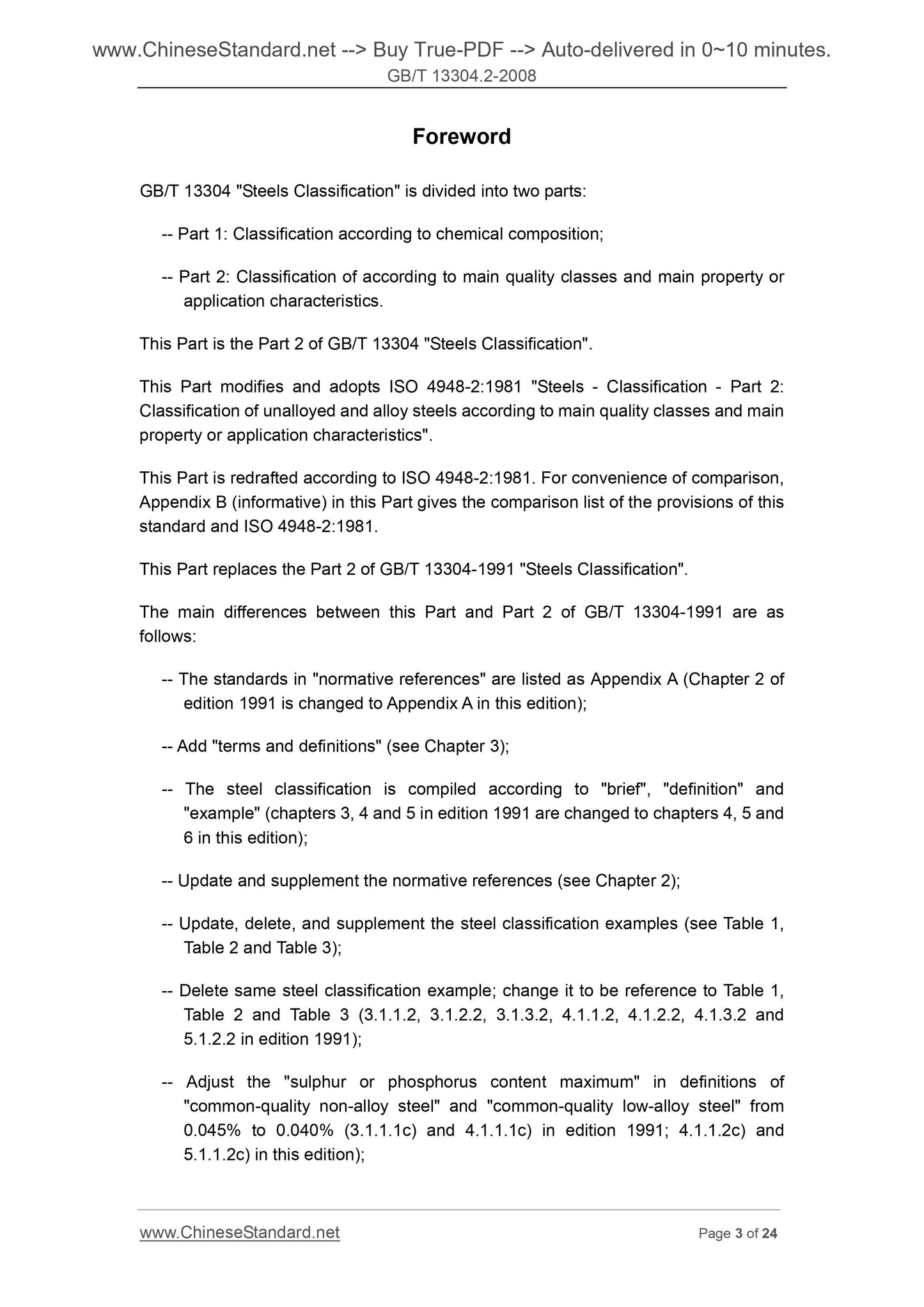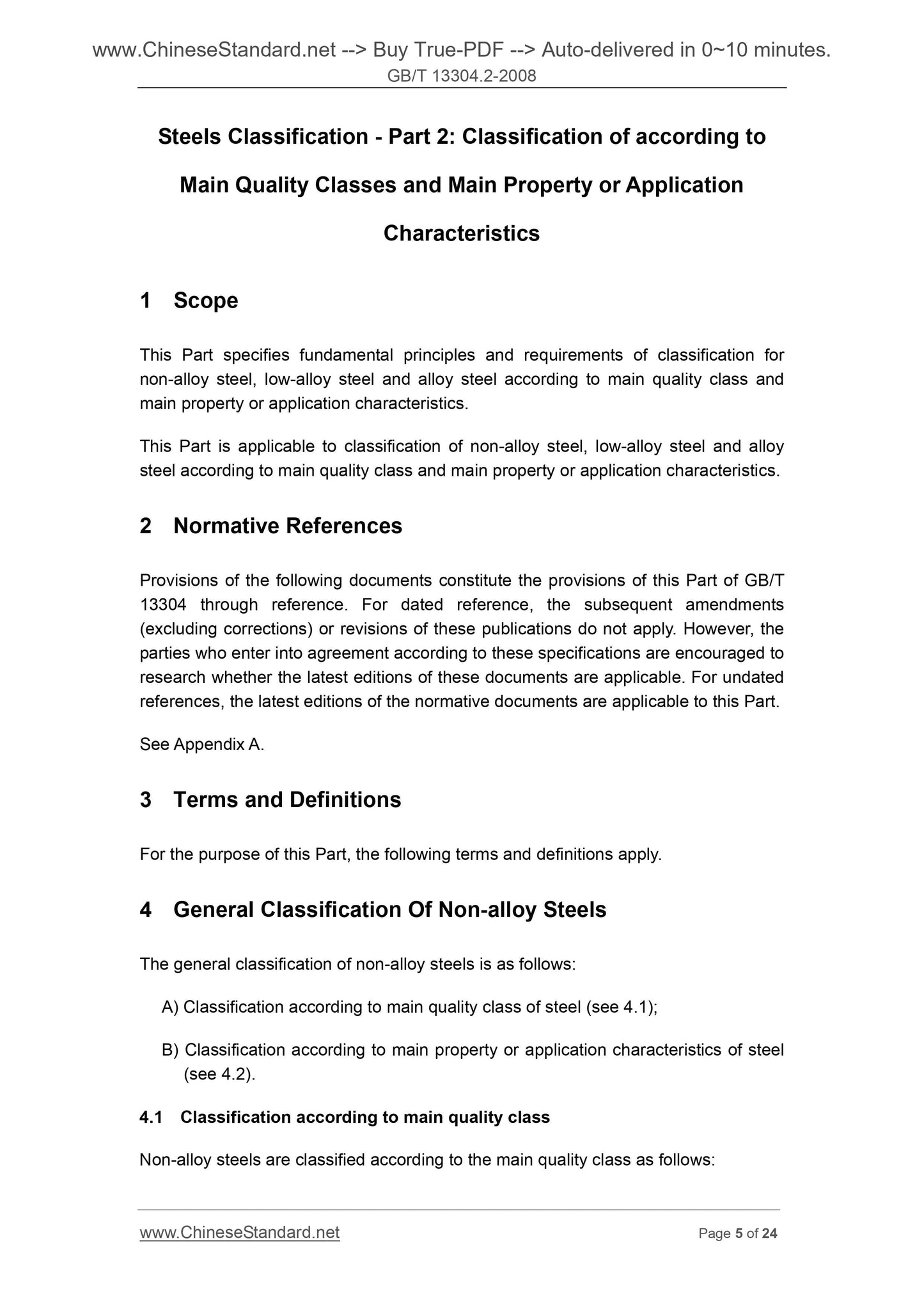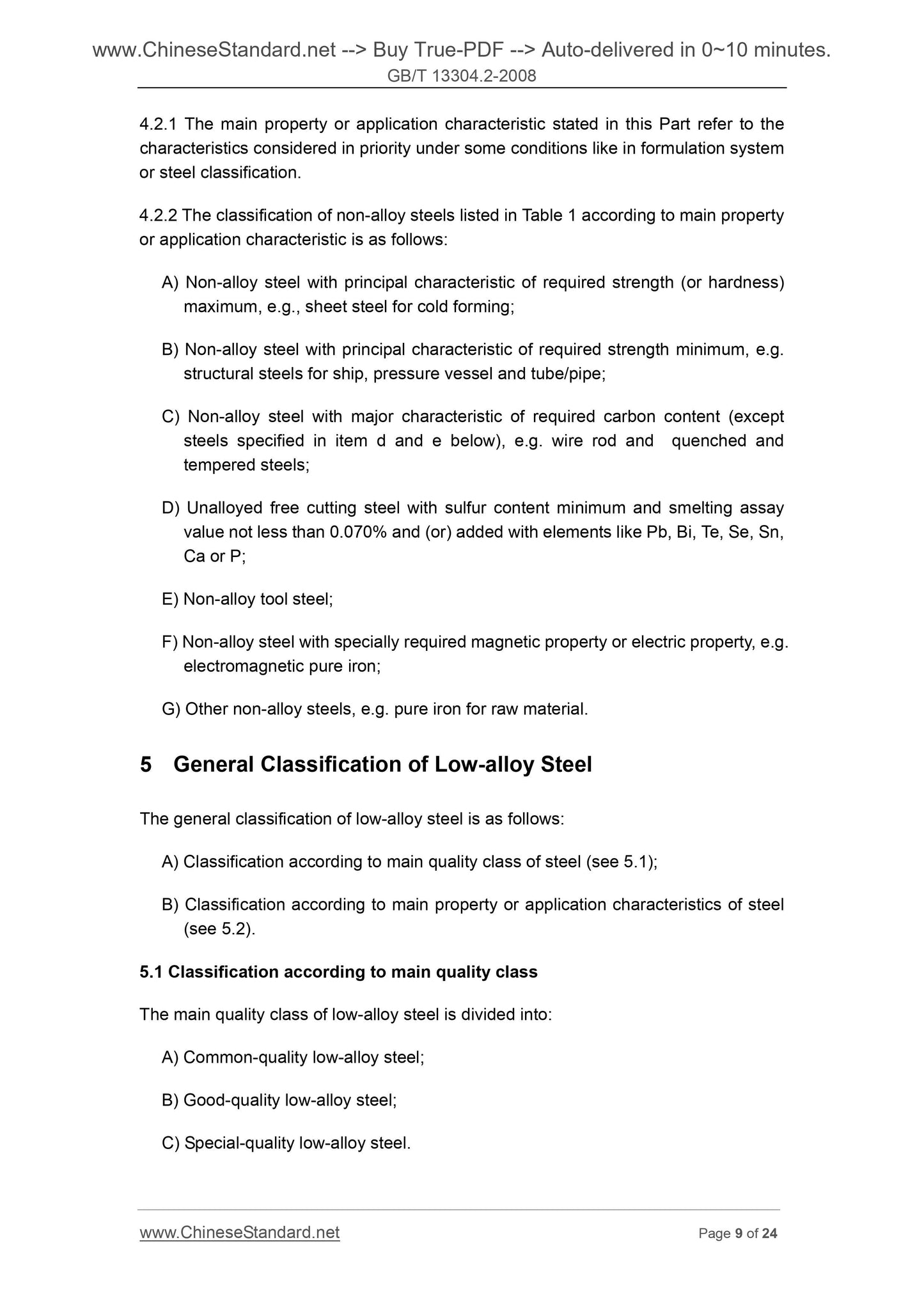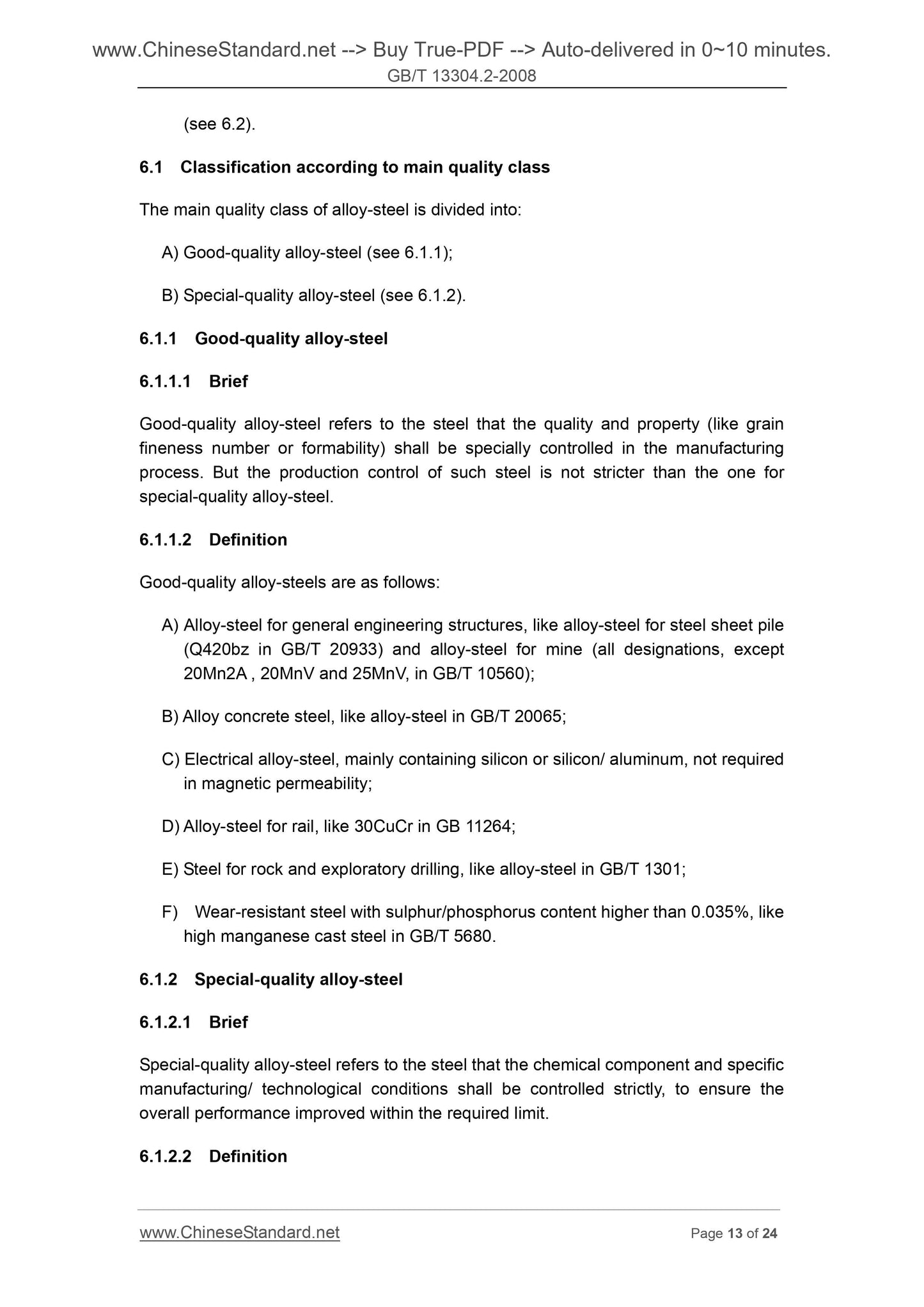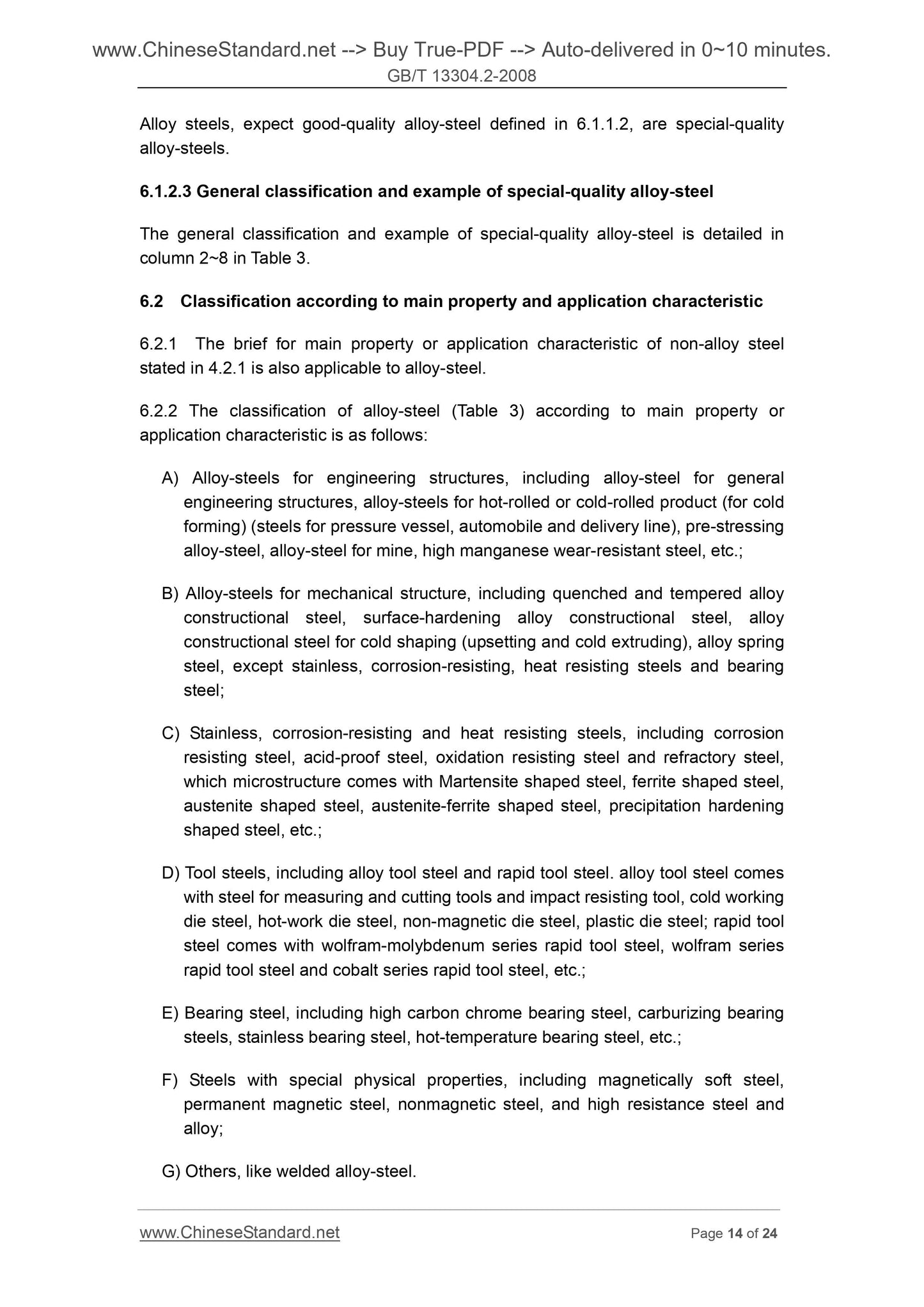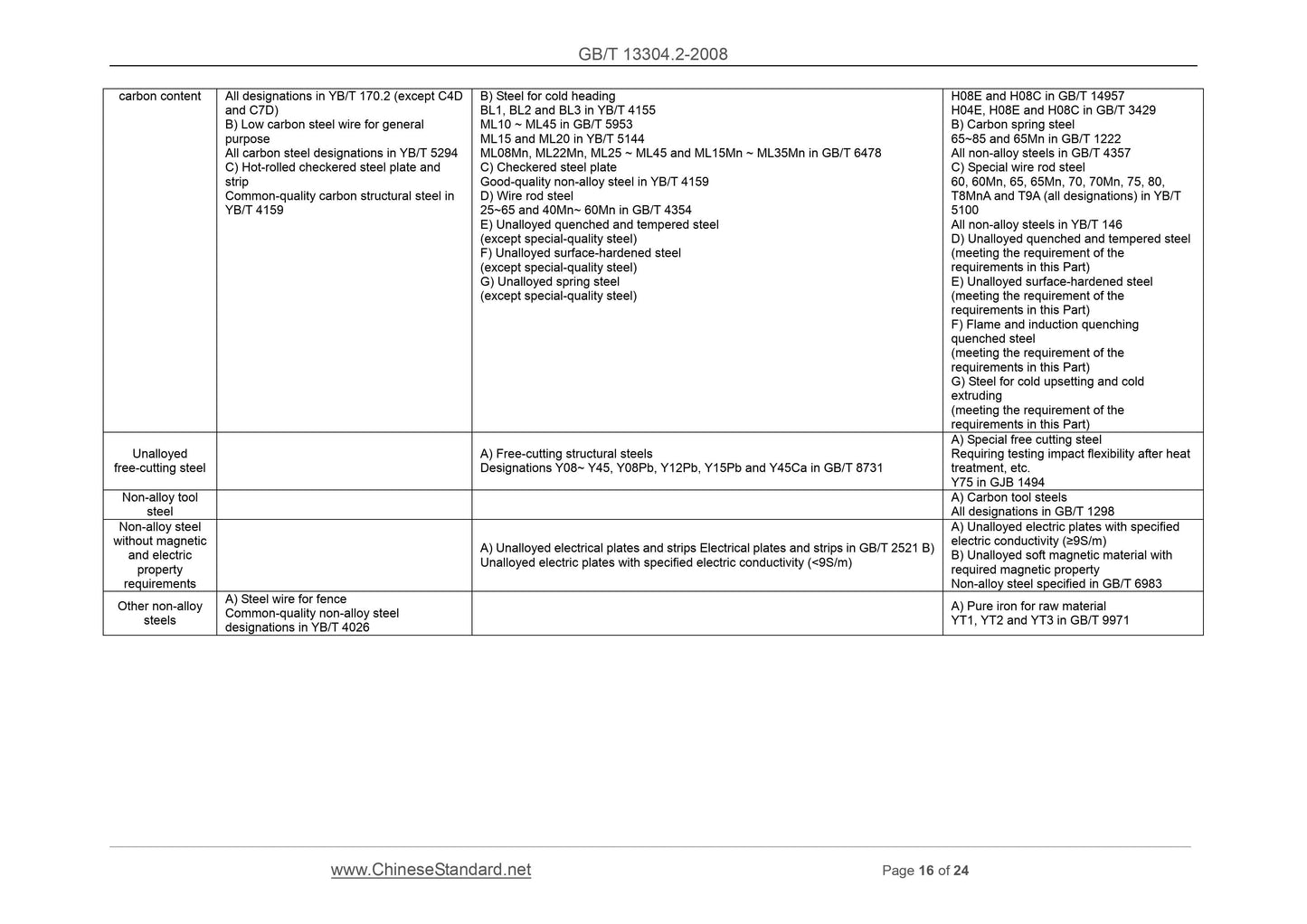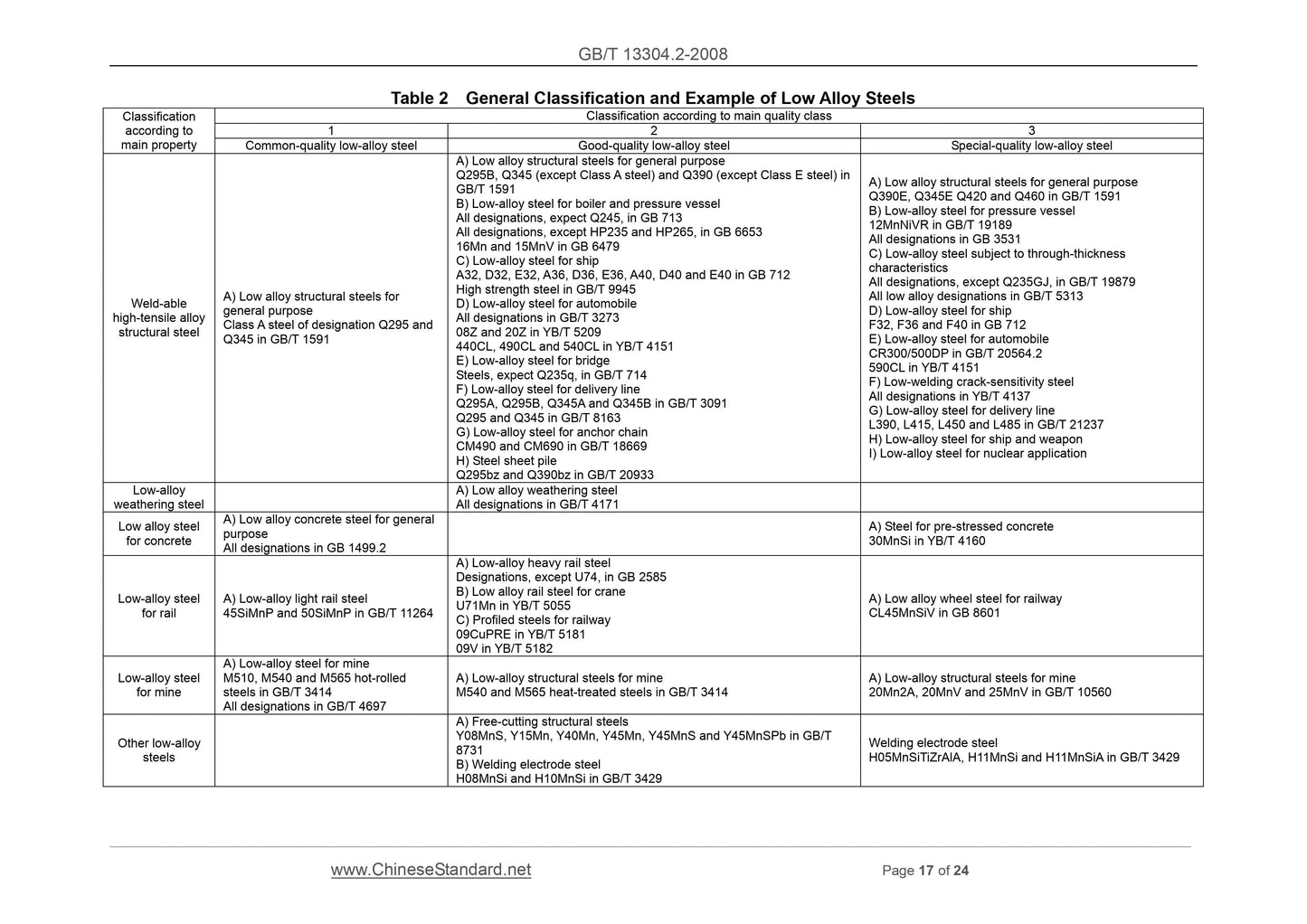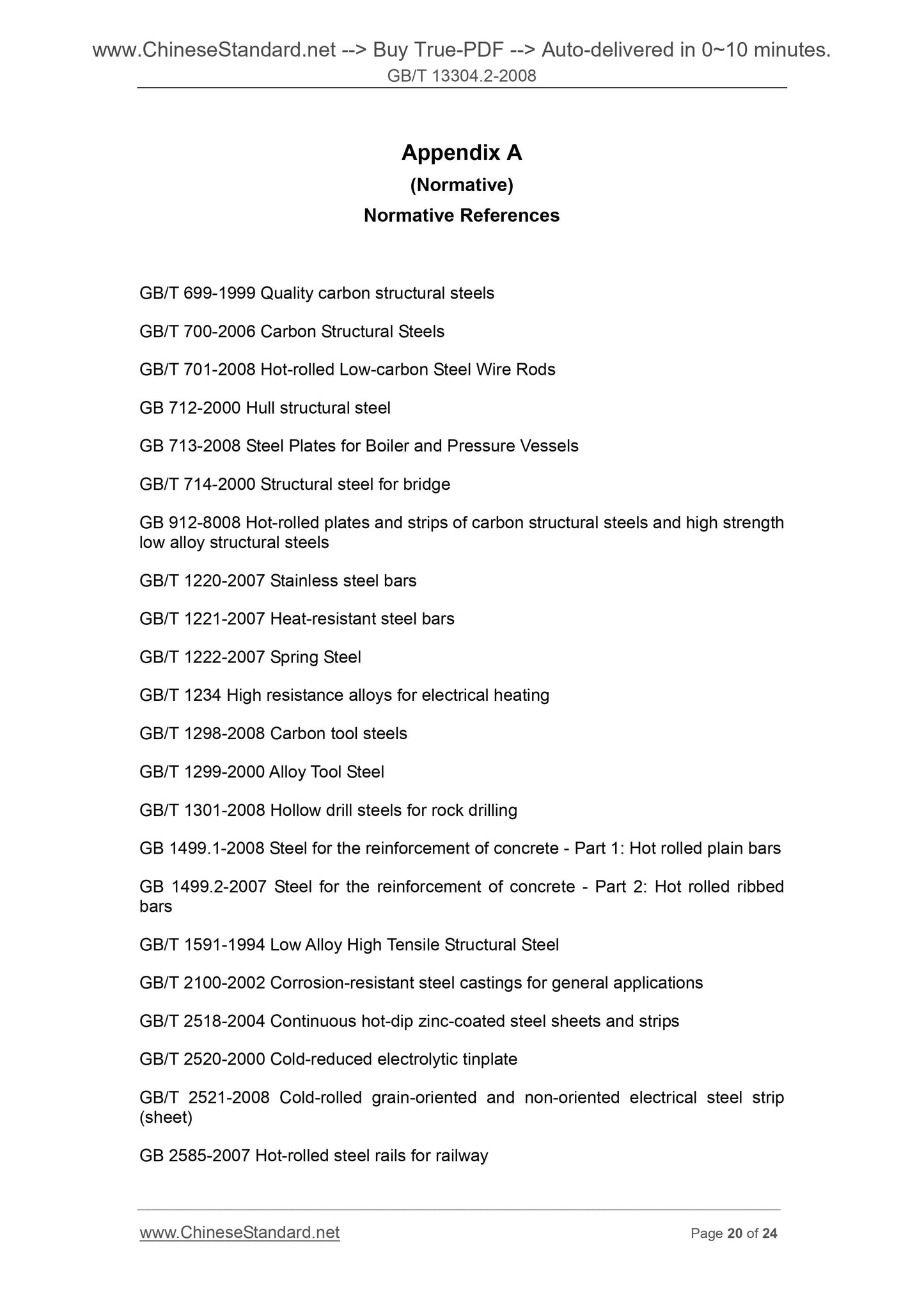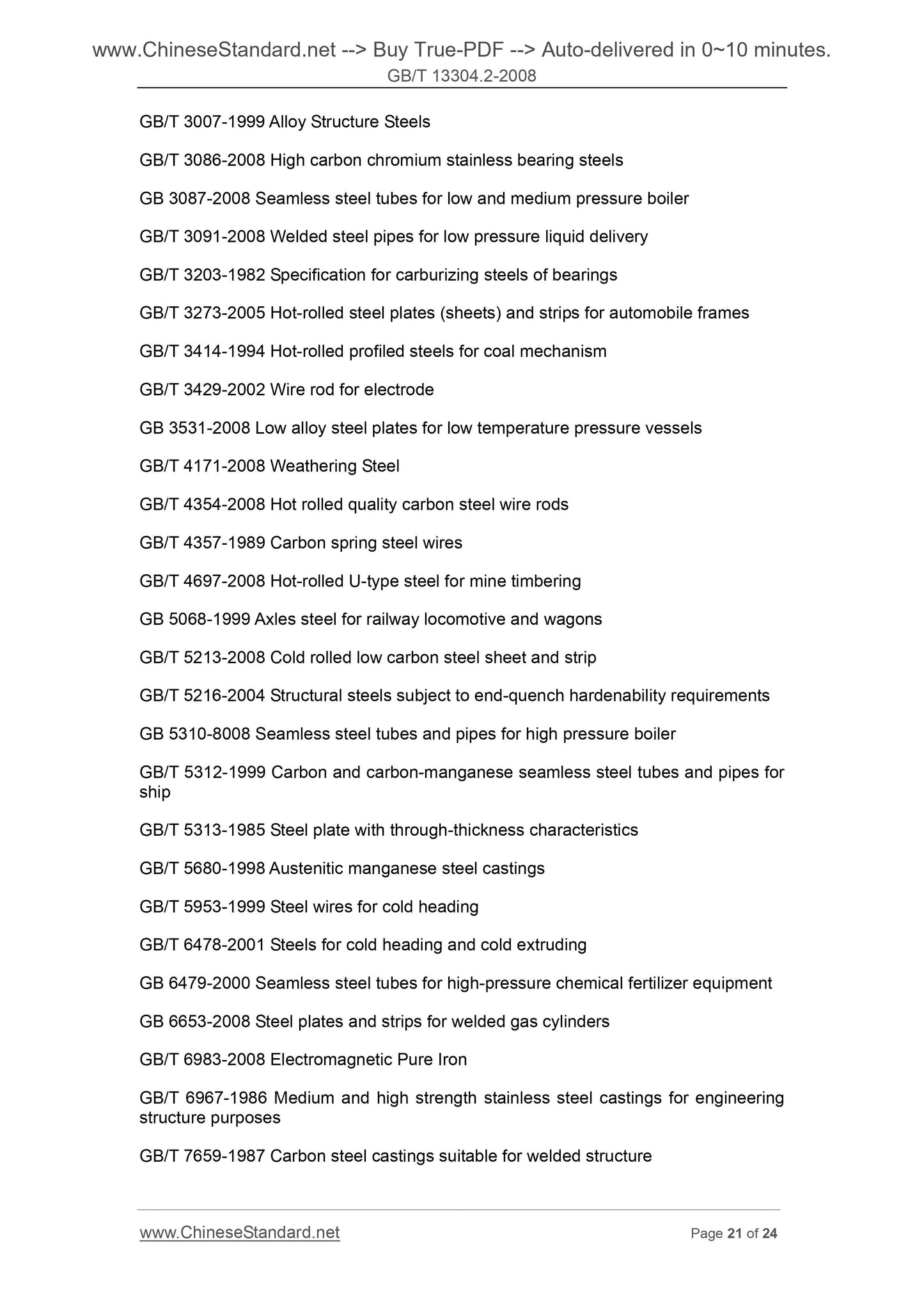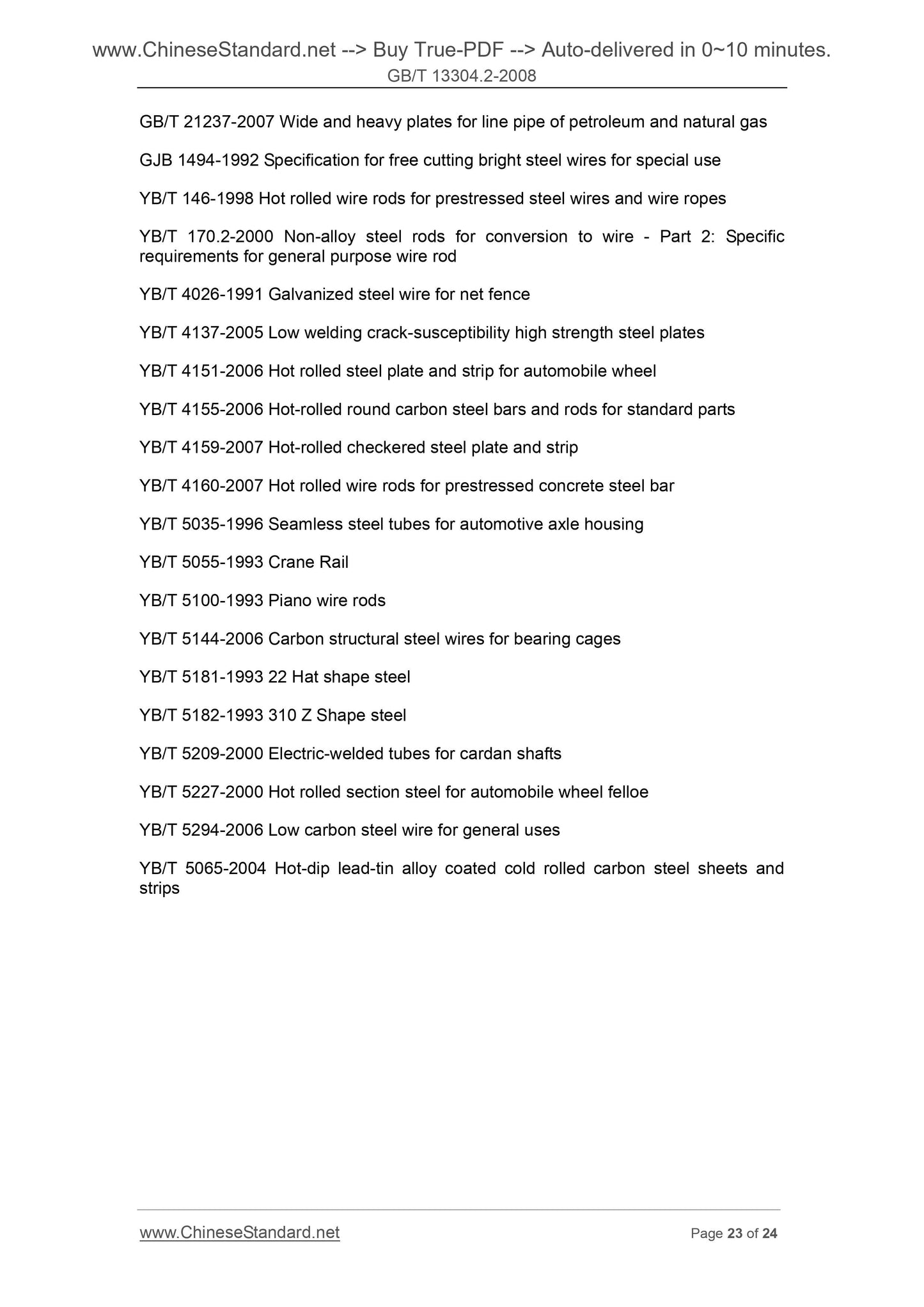1
/
of
12
PayPal, credit cards. Download editable-PDF and invoice in 1 second!
GB/T 13304.2-2008 English PDF (GBT13304.2-2008)
GB/T 13304.2-2008 English PDF (GBT13304.2-2008)
Regular price
$85.00 USD
Regular price
Sale price
$85.00 USD
Unit price
/
per
Shipping calculated at checkout.
Couldn't load pickup availability
Delivery: 3 seconds. Download true-PDF + Invoice.
Get QUOTATION in 1-minute: Click GB/T 13304.2-2008
Historical versions: GB/T 13304.2-2008
Preview True-PDF (Reload/Scroll if blank)
GB/T 13304.2-2008: Steels classification -- Part 2: Classification of according to main quality classes and main property or application characteristics
GB/T 13304.2-2008
GB
NATIONAL STANDARD OF THE
PEOPLE’S REPUBLIC OF CHINA
ICS 77.140.01
H 40
Partially replacing GB/T 13304-1991
Steels Classification - Part 2. Classification of
According to Main Quality Classes and Main
Property or Application Characteristics
(ISO 4948-2.1981, MOD)
ISSUED ON. AUGUST 5, 2008
IMPLEMENTED ON. MARCH 1, 2009
Jointly issued by. General Administration for Quality Supervision and
Inspection and Quarantine;
Standardization Administration of China.
Table of Contents
1 Scope ... 5
2 Normative References ... 5
3 Terms and Definitions ... 5
4 General Classification Of Non-alloy Steels ... 5
5 General Classification of Low-alloy Steel ... 9
6 General Classification of Alloy Steel ... 12
Appendix A ... 20
Appendix B ... 24
Foreword
GB/T 13304 "Steels Classification" is divided into two parts.
-- Part 1. Classification according to chemical composition;
-- Part 2. Classification of according to main quality classes and main property or
application characteristics.
This Part is the Part 2 of GB/T 13304 "Steels Classification".
This Part modifies and adopts ISO 4948-2.1981 "Steels - Classification - Part 2.
Classification of unalloyed and alloy steels according to main quality classes and main
property or application characteristics".
This Part is redrafted according to ISO 4948-2.1981. For convenience of comparison,
Appendix B (informative) in this Part gives the comparison list of the provisions of this
standard and ISO 4948-2.1981.
This Part replaces the Part 2 of GB/T 13304-1991 "Steels Classification".
The main differences between this Part and Part 2 of GB/T 13304-1991 are as
follows.
-- The standards in "normative references" are listed as Appendix A (Chapter 2 of
edition 1991 is changed to Appendix A in this edition);
-- Add "terms and definitions" (see Chapter 3);
-- The steel classification is compiled according to "brief", "definition" and
"example" (chapters 3, 4 and 5 in edition 1991 are changed to chapters 4, 5 and
6 in this edition);
-- Update and supplement the normative references (see Chapter 2);
-- Update, delete, and supplement the steel classification examples (see Table 1,
Table 2 and Table 3);
-- Delete same steel classification example; change it to be reference to Table 1,
Table 2 and Table 3 (3.1.1.2, 3.1.2.2, 3.1.3.2, 4.1.1.2, 4.1.2.2, 4.1.3.2 and
5.1.2.2 in edition 1991);
-- Adjust the "sulphur or phosphorus content maximum" in definitions of
"common-quality non-alloy steel" and "common-quality low-alloy steel" from
0.045% to 0.040% (3.1.1.1c) and 4.1.1.1c) in edition 1991; 4.1.1.2c) and
5.1.1.2c) in this edition);
Steels Classification - Part 2. Classification of according to
Main Quality Classes and Main Property or Application
Characteristics
1 Scope
This Part specifies fundamental principles and requirements of classification for
non-alloy steel, low-alloy steel and alloy steel according to main quality class and
main property or application characteristics.
This Part is applicable to classification of non-alloy steel, low-alloy steel and alloy
steel according to main quality class and main property or application characteristics.
2 Normative References
Provisions of the following documents constitute the provisions of this Part of GB/T
13304 through reference. For dated reference, the subsequent amendments
(excluding corrections) or revisions of these publications do not apply. However, the
parties who enter into agreement according to these specifications are encouraged to
research whether the latest editions of these documents are applicable. For undated
references, the latest editions of the normative documents are applicable to this Part.
See Appendix A.
3 Terms and Definitions
For the purpose of this Part, the following terms and definitions apply.
4 General Classification Of Non-alloy Steels
The general classification of non-alloy steels is as follows.
A) Classification according to main quality class of steel (see 4.1);
B) Classification according to main property or application characteristics of steel
(see 4.2).
4.1 Classification according to main quality class
Non-alloy steels are classified according to the main quality class as follows.
4.2.1 The main property or application characteristic stated in this Part refer to the
characteristics considered in priority under some conditions like in formulation system
or steel classification.
4.2.2 The classification of non-alloy steels listed in Table 1 according to main property
or application characteristic is as follows.
A) Non-alloy steel with principal characteristic of required strength (or hardness)
maximum, e.g., sheet steel for cold forming;
B) Non-alloy steel with principal characteristic of required strength minimum, e.g.
structural steels for ship, pressure vessel and tube/pipe;
C) Non-alloy steel with major characteristic of required carbon content (except
steels specified in item d and e below), e.g. wire rod and quenched and
tempered steels;
D) Unalloyed free cutting steel with sulfur content minimum and smelting assay
value not less than 0.070% and (or) added with elements like Pb, Bi, Te, Se, Sn,
Ca or P;
E) Non-alloy tool steel;
F) Non-alloy steel with specially required magnetic property or electric property, e.g.
electromagnetic pure iron;
G) Other non-alloy steels, e.g. pure iron for raw material.
5 General Classification of Low-alloy Steel
The general classification of low-alloy steel is as follows.
A) Classification according to main quality class of steel (see 5.1);
B) Classification according to main property or application characteristics of steel
(see 5.2).
5.1 Classification according to main quality class
The main quality class of low-alloy steel is divided into.
A) Common-quality low-alloy steel;
B) Good-quality low-alloy steel;
C) Special-quality low-alloy steel.
(see 6.2).
6.1 Classification according to main quality class
The main quality class of alloy-steel is divided into.
A) Good-quality alloy-steel (see 6.1.1);
B) Special-quality alloy-steel (see 6.1.2).
6.1.1 Good-quality alloy-steel
6.1.1.1 Brief
Good-quality alloy-steel refers to the steel that the quality and property (like grain
fineness number or formability) shall be specially controlled in the manufacturing
process. But the production control of such steel is not stricter than the one for
special-quality alloy-steel.
6.1.1.2 Definition
Good-quality alloy-steels are as follows.
A) Alloy-steel for general engineering structures, like alloy-steel for steel sheet pile
(Q420bz in GB/T 20933) and alloy-steel for mine (all designations, except
20Mn2A , 20MnV and 25MnV, in GB/T 10560);
B) Alloy concrete steel, like alloy-steel in GB/T 20065;
C) Electrical alloy-steel, mainly containing silicon or silicon/ aluminum, not required
in magnetic permeability;
D) Alloy-steel for rail, like 30CuCr in GB 11264;
E) Steel for rock and exploratory drilling, like alloy-steel in GB/T 1301;
F) Wear-resistant steel with sulphur/phosphorus content higher than 0.035%, like
high manganese cast steel in GB/T 5680.
6.1.2 Special-quality alloy-steel
6.1.2.1 Brief
Special-quality alloy-steel refers to the steel that the chemical component and specific
manufacturing/ technological conditions shall be controlled strictly, to ensure the
overall performance improved within the required limit.
6....
Get QUOTATION in 1-minute: Click GB/T 13304.2-2008
Historical versions: GB/T 13304.2-2008
Preview True-PDF (Reload/Scroll if blank)
GB/T 13304.2-2008: Steels classification -- Part 2: Classification of according to main quality classes and main property or application characteristics
GB/T 13304.2-2008
GB
NATIONAL STANDARD OF THE
PEOPLE’S REPUBLIC OF CHINA
ICS 77.140.01
H 40
Partially replacing GB/T 13304-1991
Steels Classification - Part 2. Classification of
According to Main Quality Classes and Main
Property or Application Characteristics
(ISO 4948-2.1981, MOD)
ISSUED ON. AUGUST 5, 2008
IMPLEMENTED ON. MARCH 1, 2009
Jointly issued by. General Administration for Quality Supervision and
Inspection and Quarantine;
Standardization Administration of China.
Table of Contents
1 Scope ... 5
2 Normative References ... 5
3 Terms and Definitions ... 5
4 General Classification Of Non-alloy Steels ... 5
5 General Classification of Low-alloy Steel ... 9
6 General Classification of Alloy Steel ... 12
Appendix A ... 20
Appendix B ... 24
Foreword
GB/T 13304 "Steels Classification" is divided into two parts.
-- Part 1. Classification according to chemical composition;
-- Part 2. Classification of according to main quality classes and main property or
application characteristics.
This Part is the Part 2 of GB/T 13304 "Steels Classification".
This Part modifies and adopts ISO 4948-2.1981 "Steels - Classification - Part 2.
Classification of unalloyed and alloy steels according to main quality classes and main
property or application characteristics".
This Part is redrafted according to ISO 4948-2.1981. For convenience of comparison,
Appendix B (informative) in this Part gives the comparison list of the provisions of this
standard and ISO 4948-2.1981.
This Part replaces the Part 2 of GB/T 13304-1991 "Steels Classification".
The main differences between this Part and Part 2 of GB/T 13304-1991 are as
follows.
-- The standards in "normative references" are listed as Appendix A (Chapter 2 of
edition 1991 is changed to Appendix A in this edition);
-- Add "terms and definitions" (see Chapter 3);
-- The steel classification is compiled according to "brief", "definition" and
"example" (chapters 3, 4 and 5 in edition 1991 are changed to chapters 4, 5 and
6 in this edition);
-- Update and supplement the normative references (see Chapter 2);
-- Update, delete, and supplement the steel classification examples (see Table 1,
Table 2 and Table 3);
-- Delete same steel classification example; change it to be reference to Table 1,
Table 2 and Table 3 (3.1.1.2, 3.1.2.2, 3.1.3.2, 4.1.1.2, 4.1.2.2, 4.1.3.2 and
5.1.2.2 in edition 1991);
-- Adjust the "sulphur or phosphorus content maximum" in definitions of
"common-quality non-alloy steel" and "common-quality low-alloy steel" from
0.045% to 0.040% (3.1.1.1c) and 4.1.1.1c) in edition 1991; 4.1.1.2c) and
5.1.1.2c) in this edition);
Steels Classification - Part 2. Classification of according to
Main Quality Classes and Main Property or Application
Characteristics
1 Scope
This Part specifies fundamental principles and requirements of classification for
non-alloy steel, low-alloy steel and alloy steel according to main quality class and
main property or application characteristics.
This Part is applicable to classification of non-alloy steel, low-alloy steel and alloy
steel according to main quality class and main property or application characteristics.
2 Normative References
Provisions of the following documents constitute the provisions of this Part of GB/T
13304 through reference. For dated reference, the subsequent amendments
(excluding corrections) or revisions of these publications do not apply. However, the
parties who enter into agreement according to these specifications are encouraged to
research whether the latest editions of these documents are applicable. For undated
references, the latest editions of the normative documents are applicable to this Part.
See Appendix A.
3 Terms and Definitions
For the purpose of this Part, the following terms and definitions apply.
4 General Classification Of Non-alloy Steels
The general classification of non-alloy steels is as follows.
A) Classification according to main quality class of steel (see 4.1);
B) Classification according to main property or application characteristics of steel
(see 4.2).
4.1 Classification according to main quality class
Non-alloy steels are classified according to the main quality class as follows.
4.2.1 The main property or application characteristic stated in this Part refer to the
characteristics considered in priority under some conditions like in formulation system
or steel classification.
4.2.2 The classification of non-alloy steels listed in Table 1 according to main property
or application characteristic is as follows.
A) Non-alloy steel with principal characteristic of required strength (or hardness)
maximum, e.g., sheet steel for cold forming;
B) Non-alloy steel with principal characteristic of required strength minimum, e.g.
structural steels for ship, pressure vessel and tube/pipe;
C) Non-alloy steel with major characteristic of required carbon content (except
steels specified in item d and e below), e.g. wire rod and quenched and
tempered steels;
D) Unalloyed free cutting steel with sulfur content minimum and smelting assay
value not less than 0.070% and (or) added with elements like Pb, Bi, Te, Se, Sn,
Ca or P;
E) Non-alloy tool steel;
F) Non-alloy steel with specially required magnetic property or electric property, e.g.
electromagnetic pure iron;
G) Other non-alloy steels, e.g. pure iron for raw material.
5 General Classification of Low-alloy Steel
The general classification of low-alloy steel is as follows.
A) Classification according to main quality class of steel (see 5.1);
B) Classification according to main property or application characteristics of steel
(see 5.2).
5.1 Classification according to main quality class
The main quality class of low-alloy steel is divided into.
A) Common-quality low-alloy steel;
B) Good-quality low-alloy steel;
C) Special-quality low-alloy steel.
(see 6.2).
6.1 Classification according to main quality class
The main quality class of alloy-steel is divided into.
A) Good-quality alloy-steel (see 6.1.1);
B) Special-quality alloy-steel (see 6.1.2).
6.1.1 Good-quality alloy-steel
6.1.1.1 Brief
Good-quality alloy-steel refers to the steel that the quality and property (like grain
fineness number or formability) shall be specially controlled in the manufacturing
process. But the production control of such steel is not stricter than the one for
special-quality alloy-steel.
6.1.1.2 Definition
Good-quality alloy-steels are as follows.
A) Alloy-steel for general engineering structures, like alloy-steel for steel sheet pile
(Q420bz in GB/T 20933) and alloy-steel for mine (all designations, except
20Mn2A , 20MnV and 25MnV, in GB/T 10560);
B) Alloy concrete steel, like alloy-steel in GB/T 20065;
C) Electrical alloy-steel, mainly containing silicon or silicon/ aluminum, not required
in magnetic permeability;
D) Alloy-steel for rail, like 30CuCr in GB 11264;
E) Steel for rock and exploratory drilling, like alloy-steel in GB/T 1301;
F) Wear-resistant steel with sulphur/phosphorus content higher than 0.035%, like
high manganese cast steel in GB/T 5680.
6.1.2 Special-quality alloy-steel
6.1.2.1 Brief
Special-quality alloy-steel refers to the steel that the chemical component and specific
manufacturing/ technological conditions shall be controlled strictly, to ensure the
overall performance improved within the required limit.
6....
Share
